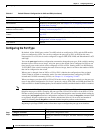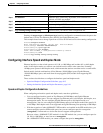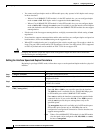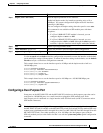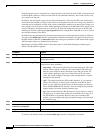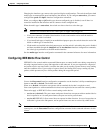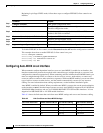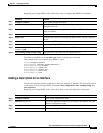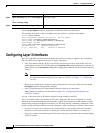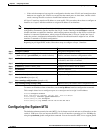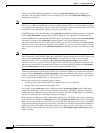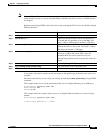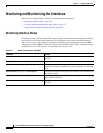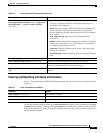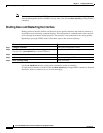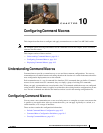
9-22
Cisco ME 3400 Ethernet Access Switch Software Configuration Guide
OL-9639-06
Chapter 9 Configuring Interfaces
Configuring Layer 3 Interfaces
Use the no description interface configuration command to delete the description.
This example shows how to add a description on a port and how to verify the description:
Switch# config terminal
Enter configuration commands, one per line. End with CNTL/Z.
Switch(config)# interface gigabitethernet0/2
Switch(config-if)# description Connects to Marketing
Switch(config-if)# end
Switch# show interfaces gigabitethernet0/2 description
Interface Status Protocol Description
Gi 0/2 admin down down Connects to Marketing
Configuring Layer 3 Interfaces
The Cisco 3400 ME switch must be running the metro IP access image to support Layer 3 interfaces.
The Cisco ME switch supports these types of Layer 3 interfaces:
• SVIs: You should configure SVIs for any VLANs for which you want to route traffic. SVIs are
created when you enter a VLAN ID following the interface vlan global configuration command. To
delete an SVI, use the no interface vlan global configuration command. You cannot delete interface
VLAN 1.
Note When you create an SVI, it does not become active until it is associated with a physical port.
For information about assigning Layer 2 ports to VLANs, see
Chapter 11, “Configuring
VLANs.”
• Routed ports: Routed ports are physical ports configured to be in Layer 3 mode by using the no
switchport interface configuration command.
• Layer 3 EtherChannel ports: EtherChannel interfaces made up of routed ports.
EtherChannel port interfaces are described in Chapter 34, “Configuring EtherChannels and
Link-State Tracking.”
A Layer 3 switch can have an IP address assigned to each routed port and SVI.
There is no defined limit to the number of SVIs and routed ports that can be configured in a switch.
However, the interrelationship between the number of SVIs and routed ports and the number of other
features being configured might have an impact on CPU usage because of hardware limitations. If the
switch is using maximum hardware resources, attempts to create a routed port or SVI have these results:
• If you try to create a new routed port, the switch generates a message that there are not enough
resources to convert the interface to a routed port, and the interface remains as a switch port.
• If you try to create an extended-range VLAN, an error message is generated, and the extended-range
VLAN is rejected.
Step 5
show interfaces interface-id description
or
show running-config
Verify your entry.
Step 6
copy running-config startup-config (Optional) Save your entries in the configuration file.
Command Purpose



